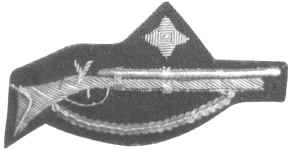 |
| Category: Badges |

|
|
|
|
|
|
Army Skill at Arms badges
Page 1 |
 |
The earliest
badges issued or awarded to Australian Colonial military men were
marksman or shooting badges. In the days of the single shot rifle
accuracy was very important. Not for them the luxury enjoyed by
today's troops of 30 round magazines and semi- automatic or full
automatic fire.
Not for them the backup of a section
machine gun, grenades, helicopter gun-ships on call and heavy artillery
waiting on line.
For the colonial soldier the term
"one shot - one kill" had real meaning. Also many men still
"shot for the pot", in other words they shot rabbits, hares,
possums, birds and sometimes even koala to supplement other food
supplies.
On country properties shooting vermin
was a constant task and it was common for boys as young as 14 to have
their own rifle.
<<<
As can be seen the various medal and badges won by
Unit shooting champions were worn on the left sleeve |
 |
 |
| 1893.
Best shot in a Regiment. 1884. Best shot in a Brigade of Artillery or a
Battalion of Infantry. Gold on
blue. |
1884.
Best shot in a Battery of Artillery, Company of the Torpedo Corps,
Engineers or Battalion. Gold
on blue. |
 |
 |
| 1893.
Worn by the sergeants in the best shooting Company of Militia Infantry. Silver
on khaki. |
Early New Zealand Volunteers Badge for
Shooting. 1866 - 1870. With 2 Silver Stars for shooting 20 points up to
900 yards. |
 |
 |
| Gold
on scarlet, c.1880 |
Variation,
circa 1880 |
 |
 |
|
Gold on scarlet,
c.1880. These 4 Marksman badges
issued in WA and Tasmania only |
 |
 |
 |
| Victorian
Volunteers.
Gold
embroidered marksmanship badges such as this were worn on the sleeve of
the left forearm, to indicate that the wearer was the best shot in his
Company. Badges could be worn until the next annual qualifying attempt
(12 months). In Victoria, during the 1860s and 1870s, marksmen who
successfully defended their ranking wore year bars to indicate the
length of time they had held the title, this (first) example being for
the period 1863 to 1867.
|
 |
Gold
embroidered marksmanship badges such as this were worn on the sleeve of
the left forearm, to indicate that the wearer was the best shot in his
Company. Badges could be worn until the next annual qualifying attempt
(12 months). |
 |
 |
 |
 |
| NSW
Volunteers marksman badge for best shot in
a Company. 1874 |
NSW.
Note the double Crowns. For best shot in a Regiment. 1887. |
NSW.
Gold on scarlet. Best shot in a Company. In use
after 1891. |
|


|
| NZ Army 1923
pattern (above) & 127 pattern (below) Skill at Arms Musketry badge. Heavy woven
cotton on khaki single rifle. Arm badge. |
 |
 |
| Silver
on khaki, post 1901, marksman badge |
Worsted
on khaki, post 1901, marksman's badge |
 |
 |
| Best
shot in each Company of Infantry or Squadron of Light Horse. c.1906 |
Best
shot in each Company of Senior Cadets. c.1906 |
 |
 |
| Gold
on blue marksman badge |
Silver
on black marksman badge. c.1903 |
 |
 |
| Silver
on khaki. c.1903 |
Worsted
marksman badge c.1910 |
 |
|
| NZ.
Not fully identified. Possibly marksman, possibly Musketry Instructor,
circa WW1 |
|
| Some
images from Australian Army Badges: Cloth insignia of the Army in
Australia 1860-1993 by J K Cossum ISBN 0 949530 14 X |
|